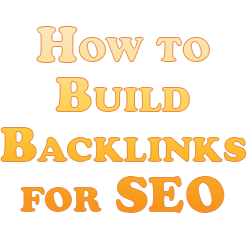
Since virtually the beginning of search engines, backlinking has remained one of the top ranking factors which contribute to a website/page’s placement in the search engine results pages (SERPs), and this is unlikely to ever change despite what those who fear Google may say.
In this article, I’ll talk a bit more about why backlinking is so evergreen and more importantly how to build backlinks for SEO both effectively and safely to improve your visibility in the search engines.
How to Build Backlinks for SEO
What is a Backlink?
Okay, let’s start off for the 4-5% of folks who are just eager to improve their SERPs positioning but still need this most basic question answered of what is a backlink.

A backlink is anything which is clickable and leads you from one website to yours.
That’s the real distinction between a link and a backlink; it’s a link to your website from another.
And just like links, backlinks can take the form of either text or images (this includes buttons).
Why Do Backlinks Matter?
Let’s get to the important question of why do backlinks matter?
Aside from the obvious answer of they provide an easy, clickable way to send traffic to your website from another, backlinks matter because they pass on influence from one website to yours.

I mentioned that backlinks remain one of the top ranking factors, even today.
The reason that this is unlikely to ever change is because Google and other search engines use backlinks as a way of appraising a website’s content from the eyes of its peers.
I like to say that when one webmaster links their website to another’s, it’s like a virtual thumbs up, or their way of vouching for that other webmaster’s content.
Google takes that sign of good content which is worth linking to, and rewards the website/page which received the link accordingly by giving it a higher placement in the SERPs for the keyword(s) it’s targeting.
What Determines a Link’s Value?
This is where things get interesting, because although it seems obvious it’s certainly still well worth stating: not all links are created equal.

Backlinks which come from sites which have more influence/authority are worth far more than those from lesser sites.
Influence/authority of a website is determined by:
- Average Traffic to That Site – More traffic implies that that site has a lot of quality content which lures in lots of visitors.
- Age of Site – Older websites are generally perceived as being more trustworthy, hence the success of the domain reselling market.
- Backlinks – This one’s a bit meta, but obviously if a lot of other influential and high quality websites are linking back to a website, then that site will in turn be perceived to be higher quality.
- Site Metrics – Websites which have positive metrics are considered more valuable, as well. If links are virtual thumbs ups from webmasters, positive site metrics showing how people interact with a website are virtual thumbs ups from website visitors.
- Site Extension – .gov or .edu sites are inherently more trustworthy because of the requisites necessary to obtain those kinds of extensions.
These are a handful of the major traits which more influential sites carry.
In other words, websites which tick a lot of these boxes carry much more weight.
The same goes for the links they give out, and the unable-to-be-precisely-measured “link juice” is much more valuable from one of these types of sites.
The Importance of Backlink Relevance
In this guide on how to build backlinks for SEO, it’s important to note the importance of relevance, though.
The reason being is that you can get a backlink from one of the top car themed websites out there, but it’s not going to do you much good if your website is all about caring for a newborn baby.
Or to put it another way, relevant links are worth far more because they help search engines better identify what your content is about and where it should rank.
Types of Backlinks
There are many types of links. Specifically here we’re going to talk about the presentation of backlinks.
I mentioned earlier that links could either be in text or image form.

As far as text goes, it can either be just a plain URL which is actually a clickable text link made up of the actual URL the link is pointing to, or it can be a clickable link like to this article titled 3 reasons the nofollow link is still your friend.
Links that fall into the latter category are useful for indicating to search engines what the linked to page’s content is about.
The clickable text is referred to as the “anchor text”.
You may think that if anchor text further specifies to search engines what the content is about then those are exclusively the kinds of links you want, but link diversity is another important factor.
The gist there is that your backlink profile, or all of the links which point to your website from other sites, should be as varied as possible.
This means a nice mixture of nofollow as well as dofollow links and links from many different websites instead of several from the same site over and over.
I mentioned “nofollow” and “dofollow”. This just distinguishes between whether or not the link passes the aforementioned influence or link juice to your site.
One of the main reasons why “nofollow” links exist is because there are many websites which allow webmasters to create backlinks to their sites from another site.
Forums and message boards are prime examples, but to discourage webmasters from just signing up and spamming said forums or message boards with links back to their websites, these links are typically designed to be “nofollow” links so that the influence that the webmaster is after doesn’t transfer.
The distinction between the two used to be more important, but the truth is that all links pass some kind of influence, and more importantly is that all links pass on traffic from one site to another.
So to sum up here, we want:
Lots of backlinks from lots of different high quality websites, both nofollow or dofollow.
How to Build Backlinks for SEO
No overview of how to build backlinks for SEO would be complete without covering how to get backlinks.
Quality Content – The most effective way to earn backlinks is through creating quality content which webmasters will want to link to.
If you have an article or resource on your site which another webmaster will feel would be beneficial to their audience then there’s a good chance that you can earn a link just by virtue of the strength of your content.

Link bait refers to a specific type of content which is designed to garner links to it.
Doing some kind of case study within your niche and creating a corresponding infographic to determine your findings is a solid way to attract other webmasters within your niche who want to share the results with their audience, as well.
Check out a few of my link bait ideas to create the kind of content which webmasters can’t resist linking to because of how much it will help their audience.
Remember that quality content also yields solid user metrics, meaning visitors will spend more time on your site if you’ve got quality content, and the search engines will take notice of this.
Consequently, they’ll reward you with better rankings which in turn improves your visibility for both visitors as well as webmasters who could link to your content.
And one more important note – don’t bother reading any further if your content stinks.
Good content is king and it facilitates nearly every other point on this list. Not sure what counts as quality content?
I’ll include a helpful link at the very end of this how to build backlinks for SEO guide to cover the finer points of creating good content.
Finding Dead Links – A nice trick is to search the websites of those you want a link from for 404 error pages.
This means that the page they are linking to from their website is unresponsive, or in other words they have a dead link on their website.
Dead links are bad for a website both in terms of how their visitors as well as the search engines view them.
Obviously visitors don’t want to hit a dead link from a website and search engines don’t want websites to have any dead links because it both shows that the site is poorly maintained as well as creates a worse user experience for the visitor.

As a result, websites with lots of dead links will experience adverse ranking effects and drop in visibility.
Using a free service like dead link checker, you can just plug in the website you want to check and it will crawl all their outgoing links to find any which result in that error.
Then you simply cold email (see 5 tips for mastering cold emailing) the webmaster and inform them of the error while offering your web page as an alternative.
You’d be surprised at how many webmasters will appreciate you doing this work for them and if your content is strong and comparable to whatever they were linking to, you’ve just earned yourself a nice link.
Checking Competitors Link Profiles – If you do a quick search for the keyword you want to rank for, you can take each of the top 10 ranking web pages for it and see which sites are linking to them.
A list of all of the links pointing to a website is known as that site’s link profile.

While backlinks aren’t 100% of the ranking factor picture, a website’s link profile can tell you a lot about why they are ranking where they are.
More importantly, once you have the link profile of your competitor(s), you can take a closer look at each of those links to identify which ones you can replicate.
In some cases you can create your own links to your website with minimal effort, like in the signature, profile, or sometimes even posts of a relevant forum.
In other cases, you may think about cold emailing the webmasters linking to your competitors and asking them to give you a link, as well, or (if your content is substantially better than that of the competitor’s page the webmaster is linking to) asking them to swap out the link altogether and point to yours instead.
That’s a nice swing in link juice in your favor, and if you’ve got the content to back it up which legitimately is better than your competitor’s, don’t be afraid to go for it.
To again mention something referenced earlier, a solid piece of link bait like a relevant infographic will really grease the wheels and do the heavy lifting for you when cold emailing another webmaster if you have that as currency.
There are hundreds of premium tools out there to identify a competitor’s backlink profile, and oftentimes it helps to have two or three tools to cross reference as no one tool can find every single link for at least a larger sized website.
I’ve put together a rundown of the most popular options on how to find competitor backlinks for free which includes both purely free options as well as limited access ones with the premium options which still yield hundreds of backlinks.
Alternatively, you can find hundreds of potential links just by doing a Google search and checking the corresponding pages which come up in the SERPs.
Just search for:
“examplesite.com” -site:examplesite.com
… replacing examplesite.com with the website name you want to check.
The pages which come up in the SERPs are the ones which explicitly list that website’s URL somewhere in the code.
The “-site” operator ensures that it doesn’t list any pages from that website itself.

This doesn’t guarantee that all, many, or practically any results that show up will be pages you can get a link for yourself from, but it’s a start and again gives you a much better idea of the kinds of sites which mention your competitor’s website.
Guest Blogging – Hopefully I don’t sound like a broken record by now, but webmasters are always looking for good content, and this obviously includes in regards to posting on their own sites.
Reaching out to a webmaster in your niche and offering to write them an article based on something on topic is a great way to get your foot in the door with them.

Just humbly request that you can include a link back to your website in some form as part of the article and it’s a win win for both of you.
Plus it encourages networking within your niche and helps you when approaching other webmasters to guest blog for them.
Social Media – Creating social network profiles for your website on all the major platforms from Facebook, Twitter, LinkedIn, Instragram, etc. and posting about your content is another traffic source where you can network with other webmasters in your niche and potentially earn a link back to your site.

Just make sure you keep an active and vibrant presence if this is your strategy where you aren’t exclusively posting self-serving content.
The idea is to be social, so connect with other webmasters in your niche on these social networks.
Make it a point to just say hey and maybe drop them a compliment regarding their site/content.
Start a conversation and let everything else take care of itself in time.
Creating Your Own Links – I’ve mentioned forums and message boards. These are generally straightforward ways to create your own links, though some require you to do a good bit of posting and establish yourself on said board before you can actually have a live link back to your website.
Unsurprisingly, these are the more valuable links you can get from the forums out there from the search engines’ perspectives because they work to cut down on spam.
I’ll sound like a dinosaur mentioning article and or website directory sites, but these are still ways to get links pointing back to your site.
However, as you might imagine, most places where you can create a link back to your website for nothing aren’t worth the time as it’s a quality over quantity world when it comes to backlinks.
Remember that wherever you’re creating links from, make sure that those sites are somehow relevant to your niche.
Private Blog Network – A good private blog network is the sole exception here, meaning it’s the one time when creating your own links can be incredibly valuable.
Note that when I say private blog network, I don’t mean someone else’s private network that you likely have little to no control over and likely have to pay the owner of that network for.

No, I mean your own private blog network, a network of websites which link back to your web page/site but that is the sole footprint, meaning there is nothing else linking those two sites outside that link.
Most paramount is that they’re both hosted on different hosting accounts as well as don’t publicly display their WHOIS/owned by info.
Then you get into more subjective tips such as don’t share an analytics account for any of the sites involved, use a variety of different website extensions, hosting providers themselves, domain registrars, and use a variety of different CMS softwares to power those websites.
Private blog networks continue to work because, if done correctly, they look like two completely unrelated sites outside of the subject matter they’re both dealing with.
The idea is to make that link look as natural as possible as if the two sites were owned by different webmasters.
PBNs get the understandable reputation of being black hat, or being bad practice in the eyes of the search engine.
While the method I referred to is arguably not nearly as bad as purchasing a link on someone else’s network, I would argue the method I’m referring to isn’t bad at all.

Search engines have no problem with you owning multiple websites or even linking between them when applicable.
If you have two websites in the pet care niche but they deal with different focuses within that niche, there may still be a time in which you link from one to the other because that content would legitimately help your audience.
The only difference is that search engines won’t give that linked to site as much of a positive bump in the SERPs from the linking from site’s “link juice” if they see a footprint which tells them they’re essentially owned/hosted by the same person than they would if they were two completely unconnected sites.
This makes sense in their eyes because that obvious nepotism (for lack of a better word) takes away from the perceived quality of that link, regardless of how good the content is.
But if you take away that obvious connection, then you get the rankings boost that it deserves.
So there’s my long exposition regarding why using your own private blog networks can work. It gets expensive, though, buying multiple domains and a hosting account for each of them.
More than that, the best domains are those which you can buy in a resellers market like GoDaddy’s auction as these are sites which potentially have been around for years and have some of that credibility built up in Google and other search engines’ eyes.
It’s also a lot of work, as each site should be of high quality with lots of content.
You can’t just buy a new site, throw up a couple pages, and link to the site/page you want to rank and expect results.
Put in the time and make each site quality in the eyes of Google.
Buying Links – Just because you’re probably curious about it, buying links is a thing but yes it’s also a bad practice and if Google or other search engines pick up on this (and they get better at this every day) you will suffer severe consequences including getting de-indexed from the search engines altogether.

Whatever short term boost you may get from it are not worth it in the long run.
Internal Links – While not strictly a backlink strategy, it’s still important to mention that it’s important that you spread your own internal link juice around where relevant and when applicable.
You’ve noticed there have been a handful of links throughout this article which point to other, relevant articles on this website.
So if you have a page on your website which has received a quality link from a high trafficked website, make sure you link from that page to other relevant pages on your site to spread that traffic and link juice around to help other pages of your site.
This also keeps people on your website and improves your user metrics.
In Conclusion…
This is a good place to finish by driving home the point that backlinking really is designed to snowball in your favor over time.
The more links you get, the better your search engine ranking.
The better your search engine ranking, the greater your visibility.
The greater your visibility, the more traffic you’ll receive.
More traffic means more positive user metrics and more webmasters who will find and link to your content (assuming your content is good).
The whole process then cycles anew as you continue to rise up in the SERPs.
But again… none of this means a thing if your content sucks.
